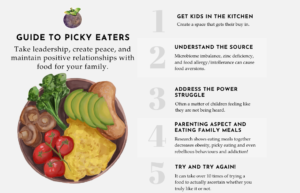27 Sep 5 Ways To Overcome Picky Eating

Do you have a picky eater in your house or perhaps you struggle to eat foods that you know are good for you? Embarking on the quest to overcome picky eating is a journey many parents find themselves navigating. As mealtime battles become a familiar scene, it’s easy to feel overwhelmed and disheartened. From understanding the roots of selective eating to discovering creative ways to broaden their palate, we’ll delve into a world where the dinner table transforms from a battleground into a place of exploration and peace. Join us on this expedition towards overcoming picky eating and fostering a positive relationship with food that will benefit both you and your little ones. We all know Mama (and Dad) could use some peace around here!
Get kids in the kitchen.
Encouraging kids to step into the kitchen is akin to opening a gateway to a world of culinary exploration and newfound appreciation for diverse flavors. Beyond the culinary skills they acquire, involving children in meal preparation has a remarkable impact on mitigating picky eating habits. As they actively participate in choosing ingredients, measuring portions, and engaging in the cooking process, kids develop a sense of ownership over their meals. This hands-on experience not only nurtures their curiosity but also demystifies the origin of food, transforming it from an unfamiliar entity into a tangible creation. Through this immersive journey, children often become more willing to try new foods, fostering a positive relationship with the diverse array of tastes that the world of cuisine has to offer. Getting kids in the kitchen becomes a transformative tool in the battle against picky eating, shaping them into adventurous eaters one recipe at a time. Even elementary age kids can make their own lunch or snack. If overeating “snacky” foods becomes a problem create a snack box to last the whole week and when those options are gone for the week, they are gone! Click here for a great guide to age appropriate tasks that your kids can do in the kitchen.

Tell the truth in love.
Kids will catch on if we deceive them (hiding foods, lying about ingredients …”there aren’t onions in this right?!?!”). They will lose faith in us and in trying foods that are new. Let them know what they’re eating and take it or leave it. This also includes the tiny tastes rule where you can try it and take it or leave it. This does not mean creating separate meals for picky eaters. My pickiest eating clients have consistently reported that after trying a food they didn’t like 8-10x (even spitting it out instead of swallowing it) ultimately changed their taste perceptions and helped them get over their aversions!
Understand the source.

Microbial imbalance can cause picky eating as well as digestive distress. Many kids avoid foods and whole food groups because they can’t break that type of food down or have an unknown intolerance/allergy. Zinc deficiency can also cause an altered taste perception. It’s a prevalent issue observed in many of my clients, often leading to a notable shift in taste preferences and digestion following my gut healing course.
If you know me at all, you know that the microbiome is my specialty and my passion is helping clients figure out what’s going on in their guts. For more info on the Microbiome you can check out my Microbiome Course or set up a phone call to ask about my 3 Month Gut Healing Program.
Address the power struggle.
Who loves to take their small children grocery shopping? Before everyone raises their hand (haha, or not!) let me tell you, letting kids pick out one or two new foods in the produce section can create a chance for them to have buy in and excitement around new foods as well as some fun in the store with you. Beyond that if you have the space and time a family garden is a great chance to create some ownership with kids and healthy food. Eating vegetables straight from the garden or getting to try things they picked out at the store themselves can be a lot more fun than simply eating what’s served. It also helps kids get more connected with where their food is coming from which will help them become more mindful adults!
When there are power struggles around food, it’s often a matter of children feeling like they are not being heard. You can give them as much power as possible to create buy in. An example of this would be a snack box for the week stocked with a variety of both treat/cheat foods and nutrient dense options. When the box runs out for the week, the snacks are done for the week.
This book is a great resource on how to talk to kids in a way that helps them understand their power.
Another one of my favorite resources is Ellyn Satter’s Division of responsibility. It’s a great guide to raise a child who is a joy to feed.
Parenting aspect and eating family meals.
Family dinners play a pivotal role in shaping various aspects of individuals’ lives. Research consistently highlights a robust connection between regular family meals and positive outcomes, ranging from improved academic performance and healthier eating habits among children to fostering stronger familial bonds. Beyond the dinner table, this shared experience has been linked to a reduction in substance abuse and violence. The ritual of coming together for meals not only nourishes the body but also nurtures emotional connections, creating a foundation for overall well-being and resilience in individuals.
Sometimes parents can alter kid’s behavior by being over strict or hyper-focusing on nutrition and health goals. If you need some clever, practical ways to teach your children food skills this book is a great resource.
Try and Try again.
It can take kids and adults over 10 times of trying a food to actually ascertain whether they truly like it or not. This coupled with a changing pallet and taste perception as we age means that we need to introduce and re-introduce food on a regular basis even if our picky eaters have said they don’t like it in the past. Instigating tiny tastes or allowing kids to spit out food they have aversions to (as long as they try it 3 times) can help the body recognize new textures and flavors as they age!

Changing the presentation of the food can also help with getting kids to try it! Check out this example of 6 different ways to present an apple.

photo credit: yourkidstable.com
Here’s to taking leadership, creating peace, and maintaining positive relationships with food for your family!

For more help in this area join our Family Wellness Makeover where you’ll be able to build your ideal family nutrition life by taking small, targeted and actionable steps to health and wellness.
The information provided on Nielsen Nutrition is for general informational purposes only. It is not intended to be a substitute for professional advice, diagnosis, or treatment. Always seek the advice of your physician or other qualified health provider with any questions you may have regarding a medical condition. This post may contain affiliate links, which means that we may earn a commission if you make a purchase through these links. This is at no additional cost to you and helps to support the maintenance and growth of the blog.





Pingback:How to Build a Better Smoothie – Nielsen Integrative Nutrition LLC
Posted at 00:30h, 24 January[…] get thrown off by the color! For more ideas if you have a picky eater we have some great ideas in this blog […]